Analysis of Factors Affecting Health and Well-being: Case Study
VerifiedAdded on 2021/06/11
|6
|1529
|59
Essay
AI Summary
This essay delves into the multifaceted factors influencing health and well-being, with a specific focus on health inequalities and their impact on individuals and communities. It begins by defining health and well-being, encompassing physical, mental, and social dimensions. The essay then explores various factors affecting health, including mental health and the social determinants of health such as poor housing, low income, stress, and food insecurity, with examples from a case study. It examines the concept of health inequalities and equity, highlighting disparities within populations and the potential impacts of poor health on individuals, such as the case study of Mr. and Mrs. Patel. The analysis underscores the importance of addressing these inequalities through social measures and policy interventions to promote overall health and well-being. The essay references WHO guidelines and other relevant research to support its arguments, emphasizing the interconnectedness of health, social factors, and individual experiences.
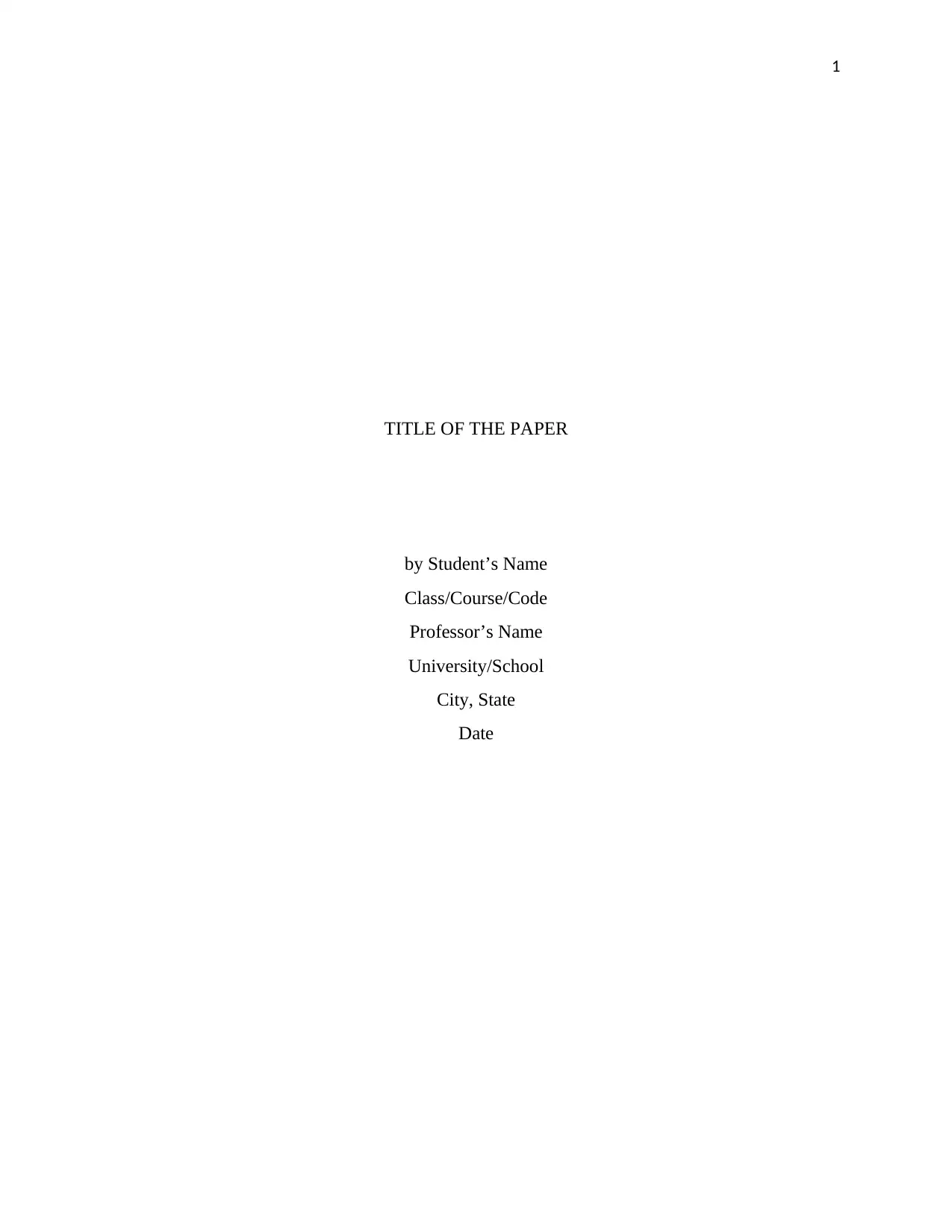
1
TITLE OF THE PAPER
by Student’s Name
Class/Course/Code
Professor’s Name
University/School
City, State
Date
TITLE OF THE PAPER
by Student’s Name
Class/Course/Code
Professor’s Name
University/School
City, State
Date
Paraphrase This Document
Need a fresh take? Get an instant paraphrase of this document with our AI Paraphraser
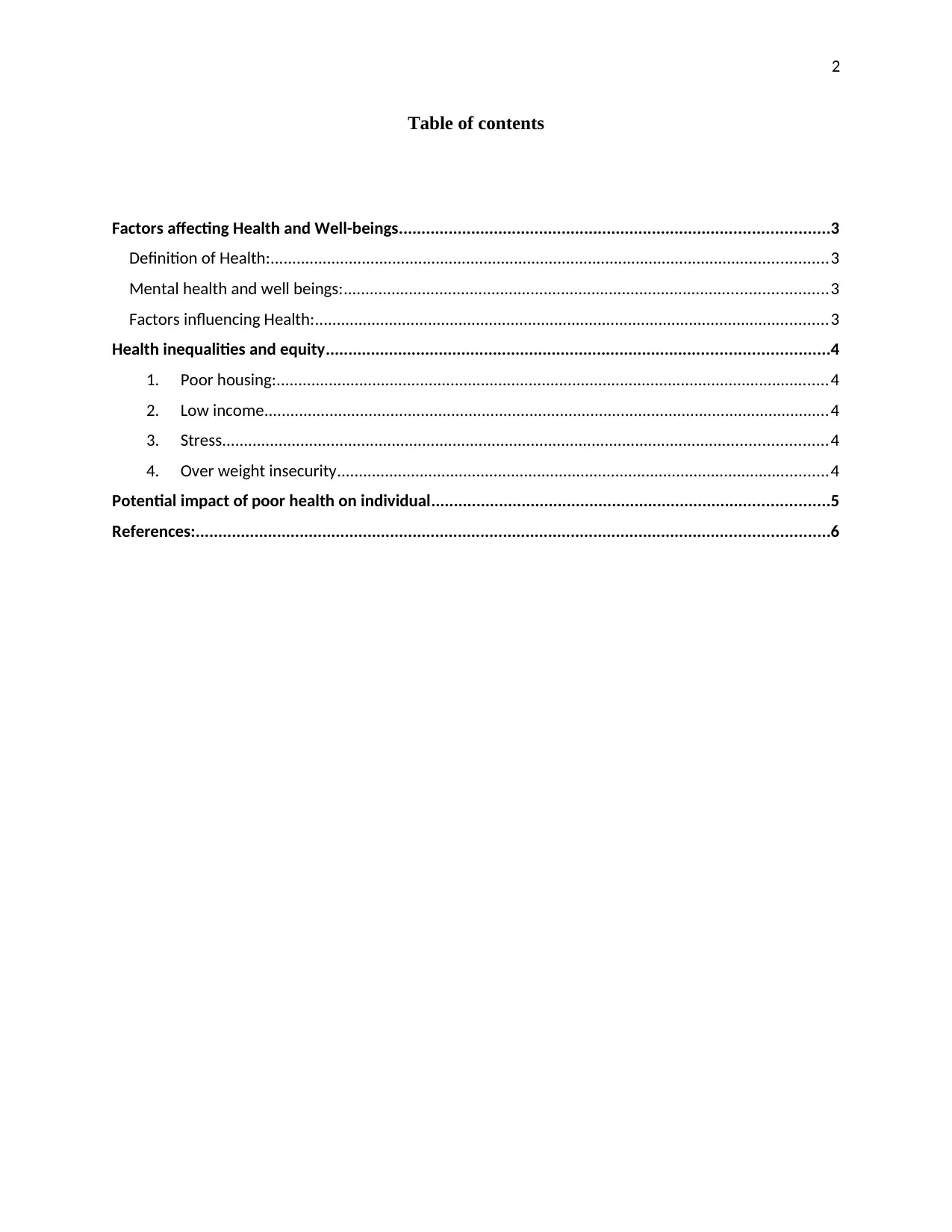
2
Table of contents
Factors affecting Health and Well-beings...............................................................................................3
Definition of Health:................................................................................................................................3
Mental health and well beings:...............................................................................................................3
Factors influencing Health:......................................................................................................................3
Health inequalities and equity...............................................................................................................4
1. Poor housing:...............................................................................................................................4
2. Low income..................................................................................................................................4
3. Stress...........................................................................................................................................4
4. Over weight insecurity.................................................................................................................4
Potential impact of poor health on individual........................................................................................5
References:............................................................................................................................................6
Table of contents
Factors affecting Health and Well-beings...............................................................................................3
Definition of Health:................................................................................................................................3
Mental health and well beings:...............................................................................................................3
Factors influencing Health:......................................................................................................................3
Health inequalities and equity...............................................................................................................4
1. Poor housing:...............................................................................................................................4
2. Low income..................................................................................................................................4
3. Stress...........................................................................................................................................4
4. Over weight insecurity.................................................................................................................4
Potential impact of poor health on individual........................................................................................5
References:............................................................................................................................................6
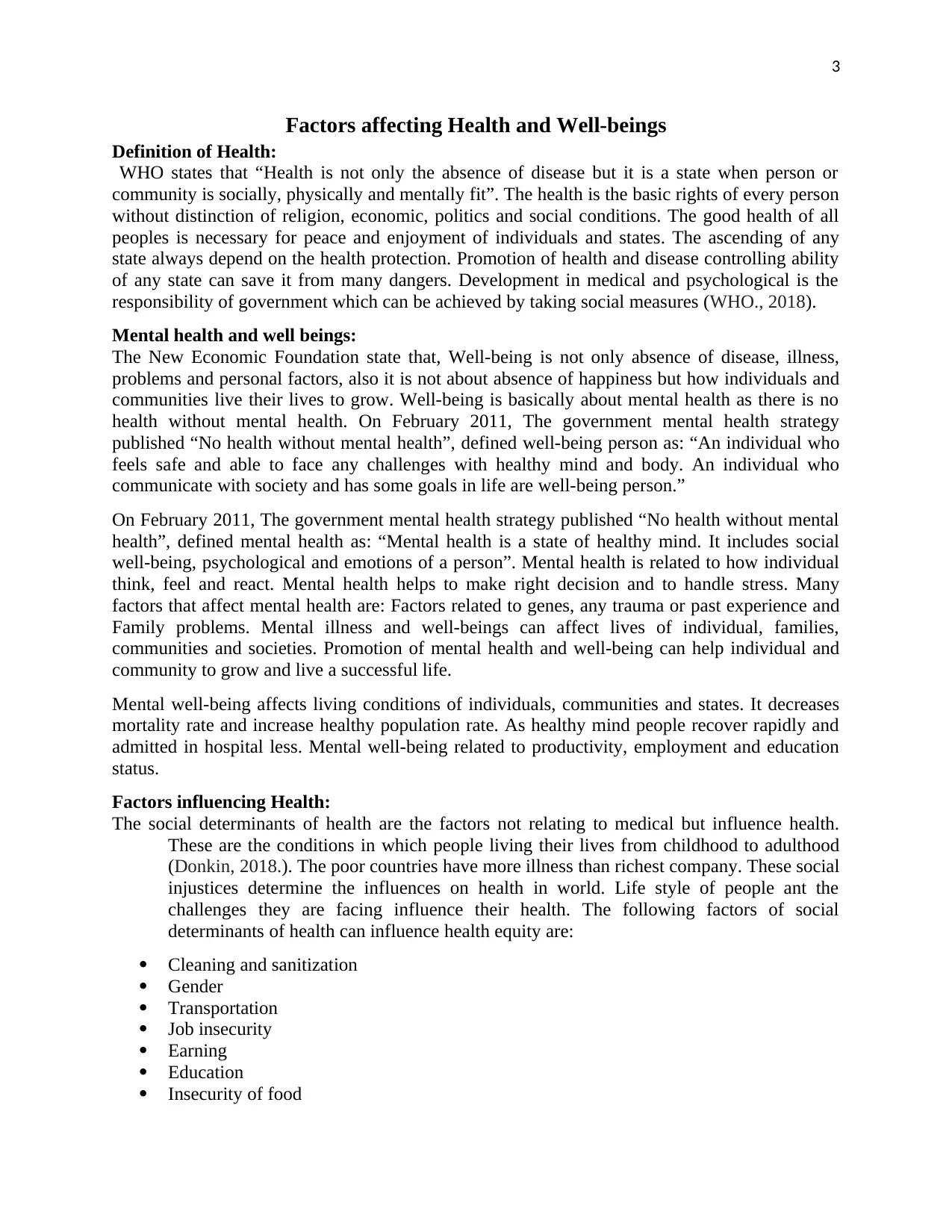
3
Factors affecting Health and Well-beings
Definition of Health:
WHO states that “Health is not only the absence of disease but it is a state when person or
community is socially, physically and mentally fit”. The health is the basic rights of every person
without distinction of religion, economic, politics and social conditions. The good health of all
peoples is necessary for peace and enjoyment of individuals and states. The ascending of any
state always depend on the health protection. Promotion of health and disease controlling ability
of any state can save it from many dangers. Development in medical and psychological is the
responsibility of government which can be achieved by taking social measures (WHO., 2018).
Mental health and well beings:
The New Economic Foundation state that, Well-being is not only absence of disease, illness,
problems and personal factors, also it is not about absence of happiness but how individuals and
communities live their lives to grow. Well-being is basically about mental health as there is no
health without mental health. On February 2011, The government mental health strategy
published “No health without mental health”, defined well-being person as: “An individual who
feels safe and able to face any challenges with healthy mind and body. An individual who
communicate with society and has some goals in life are well-being person.”
On February 2011, The government mental health strategy published “No health without mental
health”, defined mental health as: “Mental health is a state of healthy mind. It includes social
well-being, psychological and emotions of a person”. Mental health is related to how individual
think, feel and react. Mental health helps to make right decision and to handle stress. Many
factors that affect mental health are: Factors related to genes, any trauma or past experience and
Family problems. Mental illness and well-beings can affect lives of individual, families,
communities and societies. Promotion of mental health and well-being can help individual and
community to grow and live a successful life.
Mental well-being affects living conditions of individuals, communities and states. It decreases
mortality rate and increase healthy population rate. As healthy mind people recover rapidly and
admitted in hospital less. Mental well-being related to productivity, employment and education
status.
Factors influencing Health:
The social determinants of health are the factors not relating to medical but influence health.
These are the conditions in which people living their lives from childhood to adulthood
(Donkin, 2018.). The poor countries have more illness than richest company. These social
injustices determine the influences on health in world. Life style of people ant the
challenges they are facing influence their health. The following factors of social
determinants of health can influence health equity are:
Cleaning and sanitization
Gender
Transportation
Job insecurity
Earning
Education
Insecurity of food
Factors affecting Health and Well-beings
Definition of Health:
WHO states that “Health is not only the absence of disease but it is a state when person or
community is socially, physically and mentally fit”. The health is the basic rights of every person
without distinction of religion, economic, politics and social conditions. The good health of all
peoples is necessary for peace and enjoyment of individuals and states. The ascending of any
state always depend on the health protection. Promotion of health and disease controlling ability
of any state can save it from many dangers. Development in medical and psychological is the
responsibility of government which can be achieved by taking social measures (WHO., 2018).
Mental health and well beings:
The New Economic Foundation state that, Well-being is not only absence of disease, illness,
problems and personal factors, also it is not about absence of happiness but how individuals and
communities live their lives to grow. Well-being is basically about mental health as there is no
health without mental health. On February 2011, The government mental health strategy
published “No health without mental health”, defined well-being person as: “An individual who
feels safe and able to face any challenges with healthy mind and body. An individual who
communicate with society and has some goals in life are well-being person.”
On February 2011, The government mental health strategy published “No health without mental
health”, defined mental health as: “Mental health is a state of healthy mind. It includes social
well-being, psychological and emotions of a person”. Mental health is related to how individual
think, feel and react. Mental health helps to make right decision and to handle stress. Many
factors that affect mental health are: Factors related to genes, any trauma or past experience and
Family problems. Mental illness and well-beings can affect lives of individual, families,
communities and societies. Promotion of mental health and well-being can help individual and
community to grow and live a successful life.
Mental well-being affects living conditions of individuals, communities and states. It decreases
mortality rate and increase healthy population rate. As healthy mind people recover rapidly and
admitted in hospital less. Mental well-being related to productivity, employment and education
status.
Factors influencing Health:
The social determinants of health are the factors not relating to medical but influence health.
These are the conditions in which people living their lives from childhood to adulthood
(Donkin, 2018.). The poor countries have more illness than richest company. These social
injustices determine the influences on health in world. Life style of people ant the
challenges they are facing influence their health. The following factors of social
determinants of health can influence health equity are:
Cleaning and sanitization
Gender
Transportation
Job insecurity
Earning
Education
Insecurity of food
⊘ This is a preview!⊘
Do you want full access?
Subscribe today to unlock all pages.

Trusted by 1+ million students worldwide
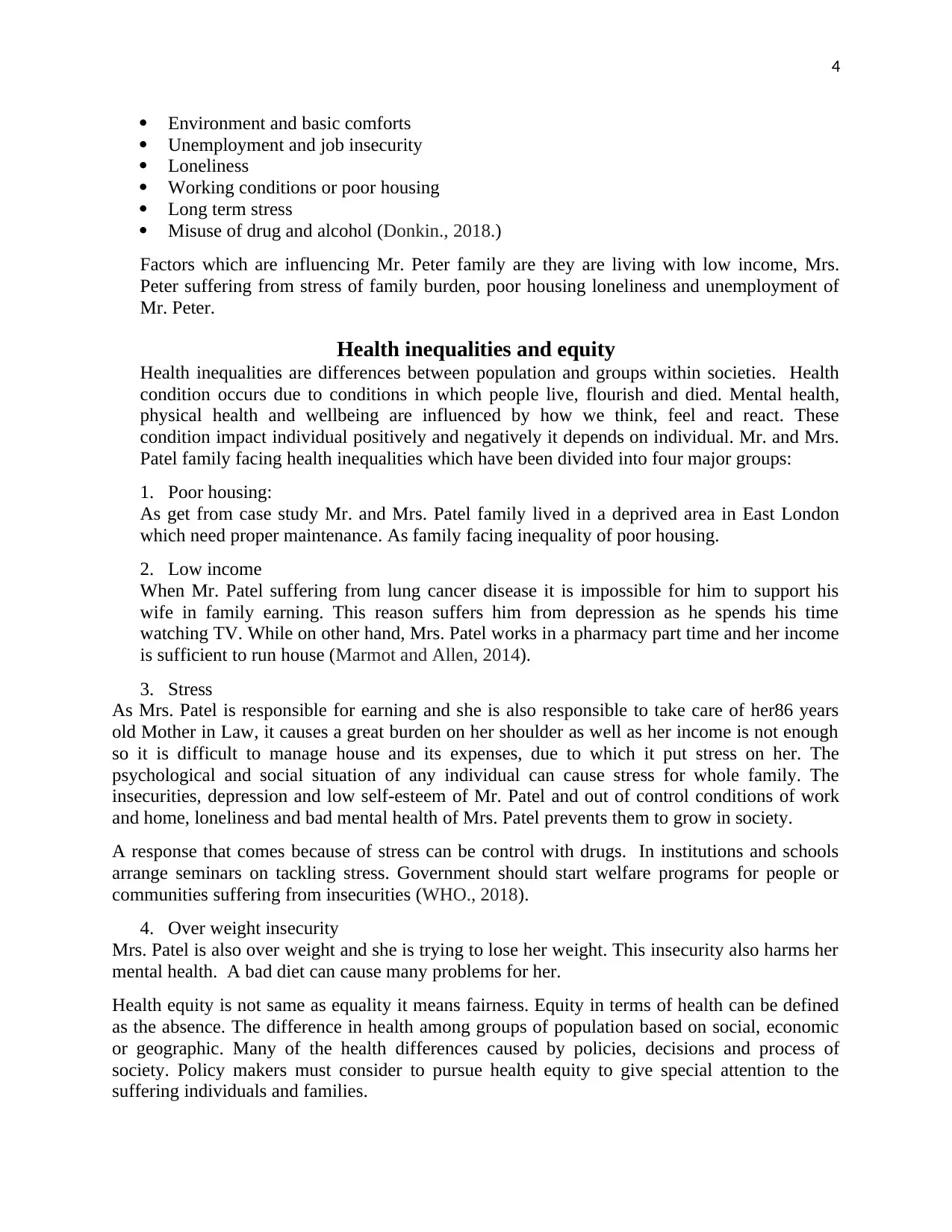
4
Environment and basic comforts
Unemployment and job insecurity
Loneliness
Working conditions or poor housing
Long term stress
Misuse of drug and alcohol (Donkin., 2018.)
Factors which are influencing Mr. Peter family are they are living with low income, Mrs.
Peter suffering from stress of family burden, poor housing loneliness and unemployment of
Mr. Peter.
Health inequalities and equity
Health inequalities are differences between population and groups within societies. Health
condition occurs due to conditions in which people live, flourish and died. Mental health,
physical health and wellbeing are influenced by how we think, feel and react. These
condition impact individual positively and negatively it depends on individual. Mr. and Mrs.
Patel family facing health inequalities which have been divided into four major groups:
1. Poor housing:
As get from case study Mr. and Mrs. Patel family lived in a deprived area in East London
which need proper maintenance. As family facing inequality of poor housing.
2. Low income
When Mr. Patel suffering from lung cancer disease it is impossible for him to support his
wife in family earning. This reason suffers him from depression as he spends his time
watching TV. While on other hand, Mrs. Patel works in a pharmacy part time and her income
is sufficient to run house (Marmot and Allen, 2014).
3. Stress
As Mrs. Patel is responsible for earning and she is also responsible to take care of her86 years
old Mother in Law, it causes a great burden on her shoulder as well as her income is not enough
so it is difficult to manage house and its expenses, due to which it put stress on her. The
psychological and social situation of any individual can cause stress for whole family. The
insecurities, depression and low self-esteem of Mr. Patel and out of control conditions of work
and home, loneliness and bad mental health of Mrs. Patel prevents them to grow in society.
A response that comes because of stress can be control with drugs. In institutions and schools
arrange seminars on tackling stress. Government should start welfare programs for people or
communities suffering from insecurities (WHO., 2018).
4. Over weight insecurity
Mrs. Patel is also over weight and she is trying to lose her weight. This insecurity also harms her
mental health. A bad diet can cause many problems for her.
Health equity is not same as equality it means fairness. Equity in terms of health can be defined
as the absence. The difference in health among groups of population based on social, economic
or geographic. Many of the health differences caused by policies, decisions and process of
society. Policy makers must consider to pursue health equity to give special attention to the
suffering individuals and families.
Environment and basic comforts
Unemployment and job insecurity
Loneliness
Working conditions or poor housing
Long term stress
Misuse of drug and alcohol (Donkin., 2018.)
Factors which are influencing Mr. Peter family are they are living with low income, Mrs.
Peter suffering from stress of family burden, poor housing loneliness and unemployment of
Mr. Peter.
Health inequalities and equity
Health inequalities are differences between population and groups within societies. Health
condition occurs due to conditions in which people live, flourish and died. Mental health,
physical health and wellbeing are influenced by how we think, feel and react. These
condition impact individual positively and negatively it depends on individual. Mr. and Mrs.
Patel family facing health inequalities which have been divided into four major groups:
1. Poor housing:
As get from case study Mr. and Mrs. Patel family lived in a deprived area in East London
which need proper maintenance. As family facing inequality of poor housing.
2. Low income
When Mr. Patel suffering from lung cancer disease it is impossible for him to support his
wife in family earning. This reason suffers him from depression as he spends his time
watching TV. While on other hand, Mrs. Patel works in a pharmacy part time and her income
is sufficient to run house (Marmot and Allen, 2014).
3. Stress
As Mrs. Patel is responsible for earning and she is also responsible to take care of her86 years
old Mother in Law, it causes a great burden on her shoulder as well as her income is not enough
so it is difficult to manage house and its expenses, due to which it put stress on her. The
psychological and social situation of any individual can cause stress for whole family. The
insecurities, depression and low self-esteem of Mr. Patel and out of control conditions of work
and home, loneliness and bad mental health of Mrs. Patel prevents them to grow in society.
A response that comes because of stress can be control with drugs. In institutions and schools
arrange seminars on tackling stress. Government should start welfare programs for people or
communities suffering from insecurities (WHO., 2018).
4. Over weight insecurity
Mrs. Patel is also over weight and she is trying to lose her weight. This insecurity also harms her
mental health. A bad diet can cause many problems for her.
Health equity is not same as equality it means fairness. Equity in terms of health can be defined
as the absence. The difference in health among groups of population based on social, economic
or geographic. Many of the health differences caused by policies, decisions and process of
society. Policy makers must consider to pursue health equity to give special attention to the
suffering individuals and families.
Paraphrase This Document
Need a fresh take? Get an instant paraphrase of this document with our AI Paraphraser
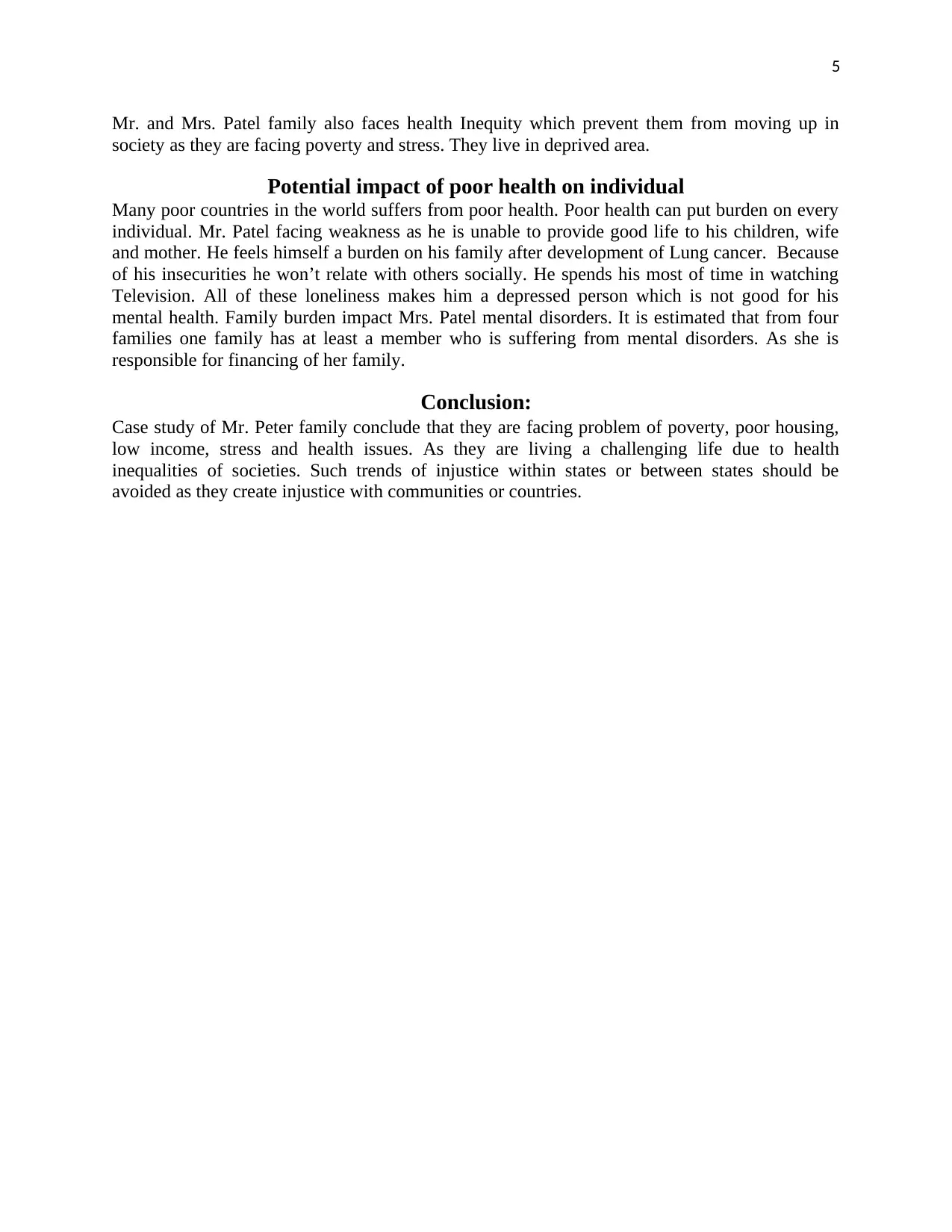
5
Mr. and Mrs. Patel family also faces health Inequity which prevent them from moving up in
society as they are facing poverty and stress. They live in deprived area.
Potential impact of poor health on individual
Many poor countries in the world suffers from poor health. Poor health can put burden on every
individual. Mr. Patel facing weakness as he is unable to provide good life to his children, wife
and mother. He feels himself a burden on his family after development of Lung cancer. Because
of his insecurities he won’t relate with others socially. He spends his most of time in watching
Television. All of these loneliness makes him a depressed person which is not good for his
mental health. Family burden impact Mrs. Patel mental disorders. It is estimated that from four
families one family has at least a member who is suffering from mental disorders. As she is
responsible for financing of her family.
Conclusion:
Case study of Mr. Peter family conclude that they are facing problem of poverty, poor housing,
low income, stress and health issues. As they are living a challenging life due to health
inequalities of societies. Such trends of injustice within states or between states should be
avoided as they create injustice with communities or countries.
Mr. and Mrs. Patel family also faces health Inequity which prevent them from moving up in
society as they are facing poverty and stress. They live in deprived area.
Potential impact of poor health on individual
Many poor countries in the world suffers from poor health. Poor health can put burden on every
individual. Mr. Patel facing weakness as he is unable to provide good life to his children, wife
and mother. He feels himself a burden on his family after development of Lung cancer. Because
of his insecurities he won’t relate with others socially. He spends his most of time in watching
Television. All of these loneliness makes him a depressed person which is not good for his
mental health. Family burden impact Mrs. Patel mental disorders. It is estimated that from four
families one family has at least a member who is suffering from mental disorders. As she is
responsible for financing of her family.
Conclusion:
Case study of Mr. Peter family conclude that they are facing problem of poverty, poor housing,
low income, stress and health issues. As they are living a challenging life due to health
inequalities of societies. Such trends of injustice within states or between states should be
avoided as they create injustice with communities or countries.
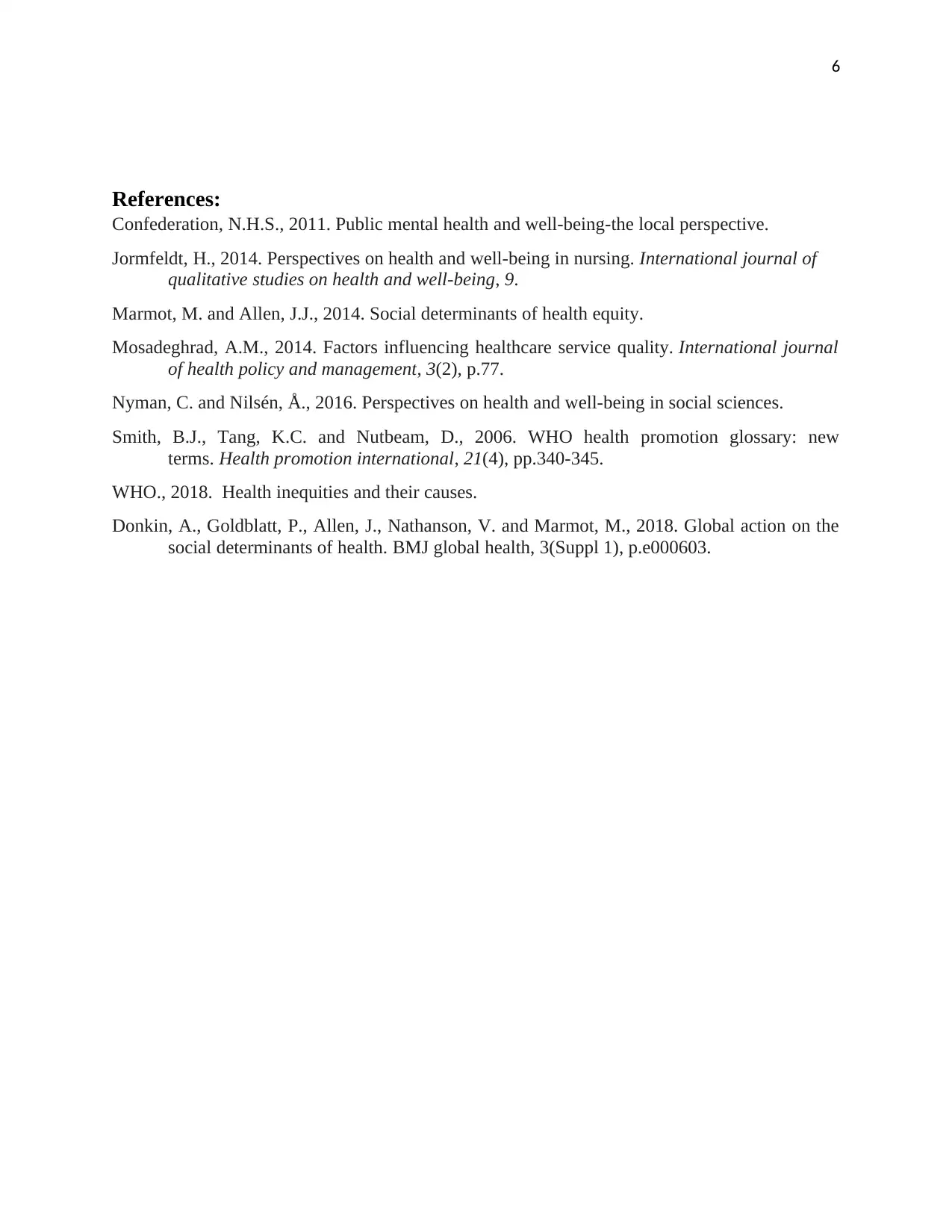
6
References:
Confederation, N.H.S., 2011. Public mental health and well-being-the local perspective.
Jormfeldt, H., 2014. Perspectives on health and well-being in nursing. International journal of
qualitative studies on health and well-being, 9.
Marmot, M. and Allen, J.J., 2014. Social determinants of health equity.
Mosadeghrad, A.M., 2014. Factors influencing healthcare service quality. International journal
of health policy and management, 3(2), p.77.
Nyman, C. and Nilsén, Å., 2016. Perspectives on health and well-being in social sciences.
Smith, B.J., Tang, K.C. and Nutbeam, D., 2006. WHO health promotion glossary: new
terms. Health promotion international, 21(4), pp.340-345.
WHO., 2018. Health inequities and their causes.
Donkin, A., Goldblatt, P., Allen, J., Nathanson, V. and Marmot, M., 2018. Global action on the
social determinants of health. BMJ global health, 3(Suppl 1), p.e000603.
References:
Confederation, N.H.S., 2011. Public mental health and well-being-the local perspective.
Jormfeldt, H., 2014. Perspectives on health and well-being in nursing. International journal of
qualitative studies on health and well-being, 9.
Marmot, M. and Allen, J.J., 2014. Social determinants of health equity.
Mosadeghrad, A.M., 2014. Factors influencing healthcare service quality. International journal
of health policy and management, 3(2), p.77.
Nyman, C. and Nilsén, Å., 2016. Perspectives on health and well-being in social sciences.
Smith, B.J., Tang, K.C. and Nutbeam, D., 2006. WHO health promotion glossary: new
terms. Health promotion international, 21(4), pp.340-345.
WHO., 2018. Health inequities and their causes.
Donkin, A., Goldblatt, P., Allen, J., Nathanson, V. and Marmot, M., 2018. Global action on the
social determinants of health. BMJ global health, 3(Suppl 1), p.e000603.
⊘ This is a preview!⊘
Do you want full access?
Subscribe today to unlock all pages.

Trusted by 1+ million students worldwide
1 out of 6
Related Documents
Your All-in-One AI-Powered Toolkit for Academic Success.
+13062052269
info@desklib.com
Available 24*7 on WhatsApp / Email
![[object Object]](/_next/static/media/star-bottom.7253800d.svg)
Unlock your academic potential
Copyright © 2020–2025 A2Z Services. All Rights Reserved. Developed and managed by ZUCOL.





